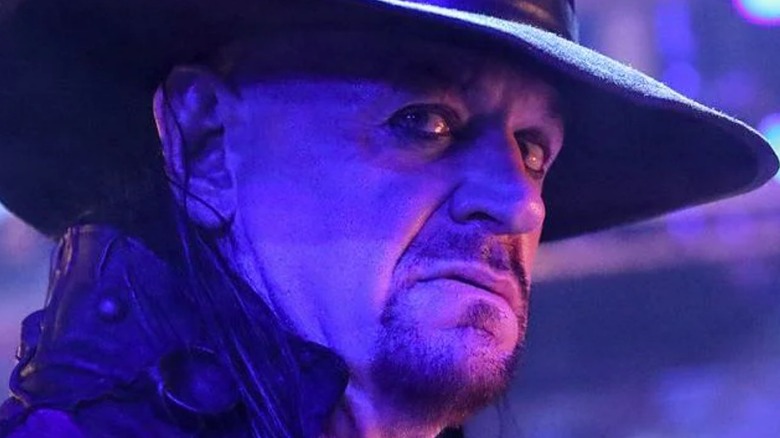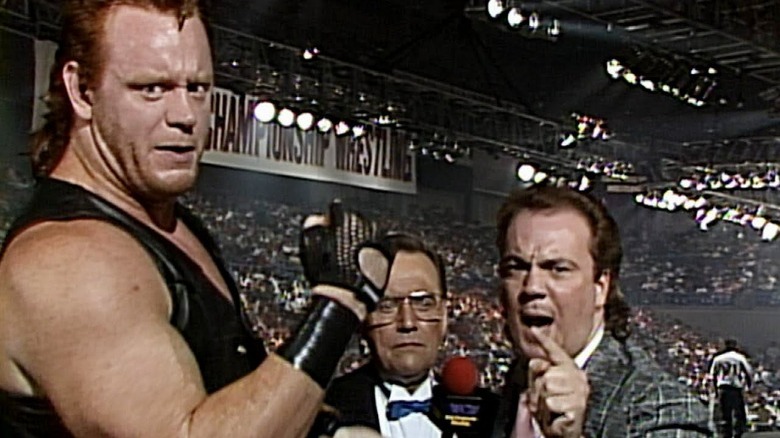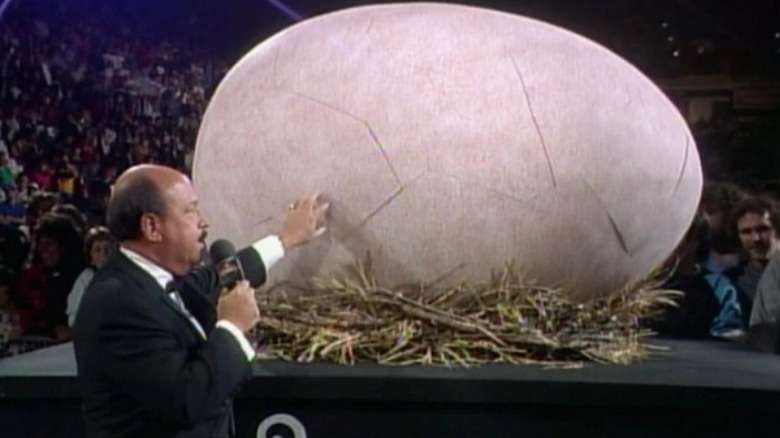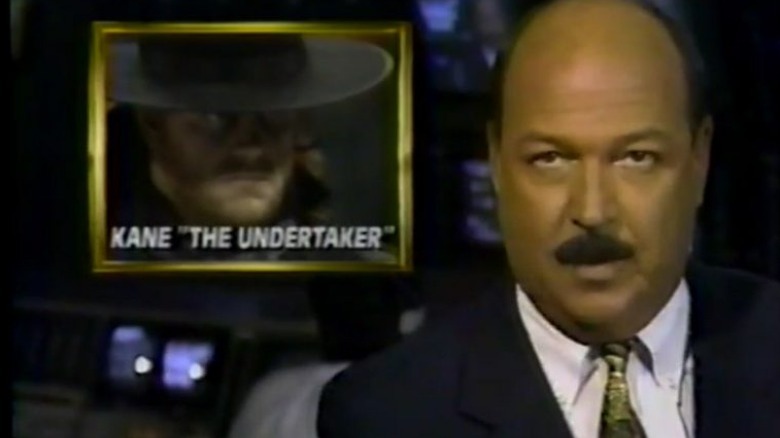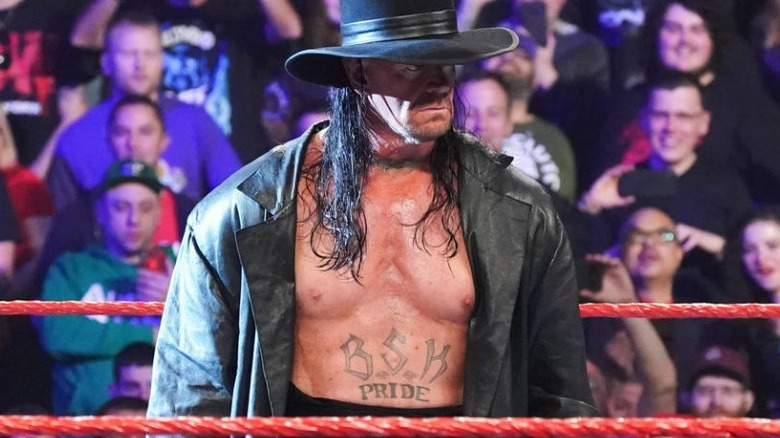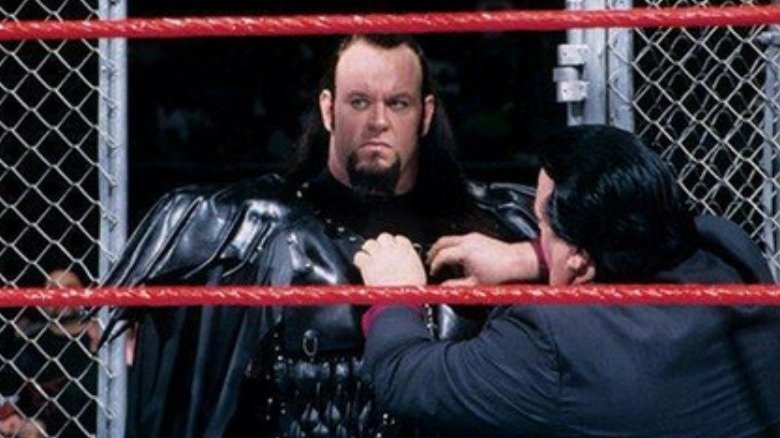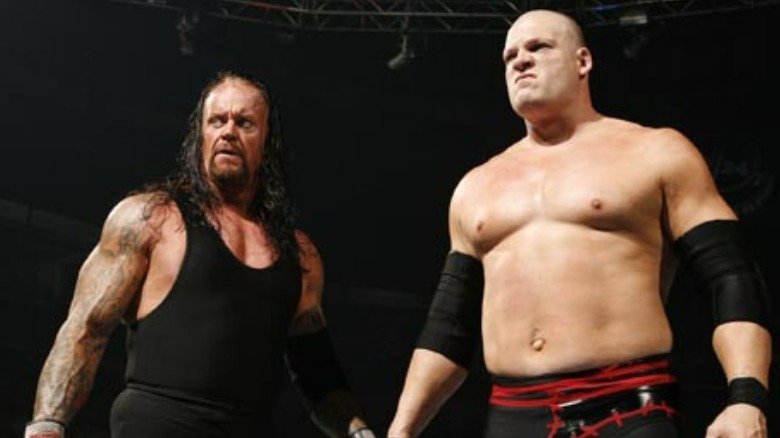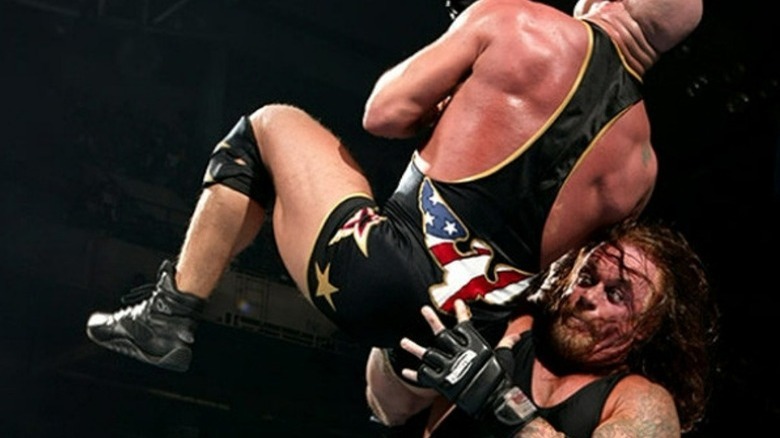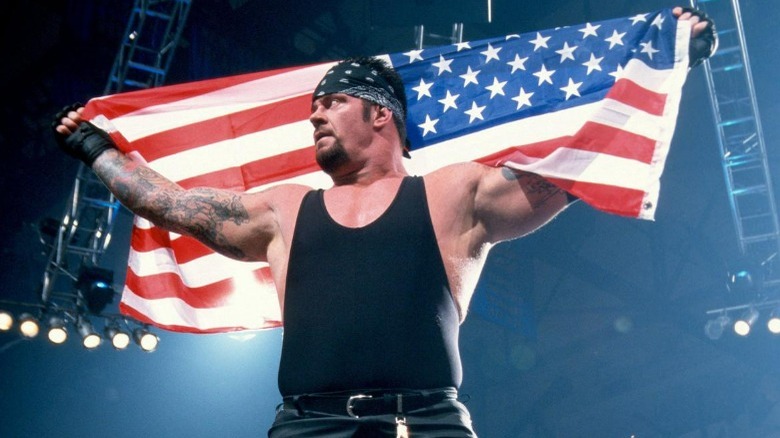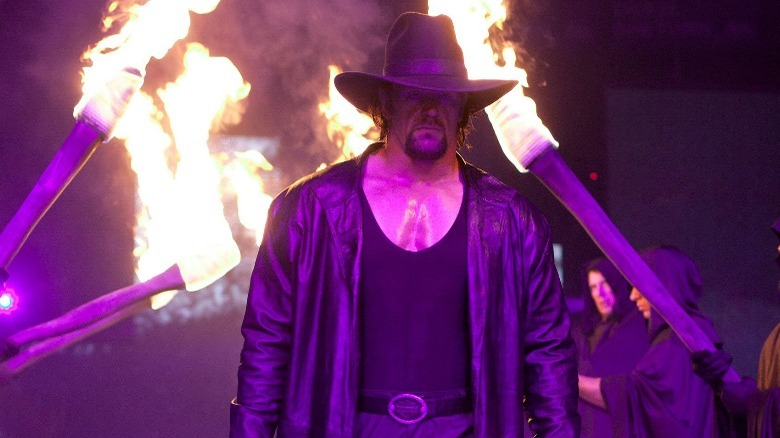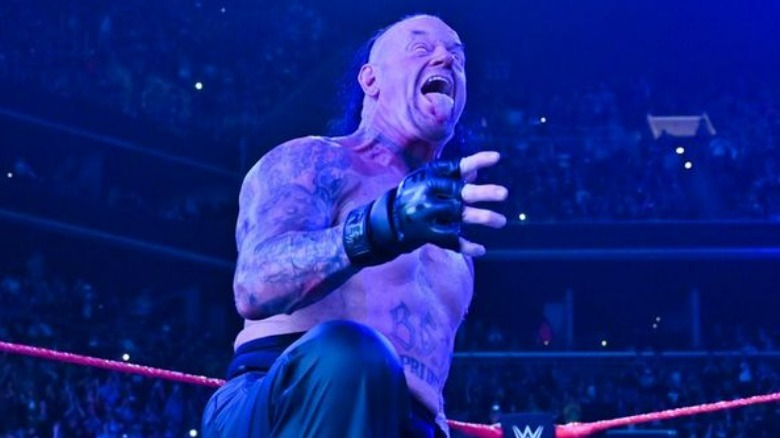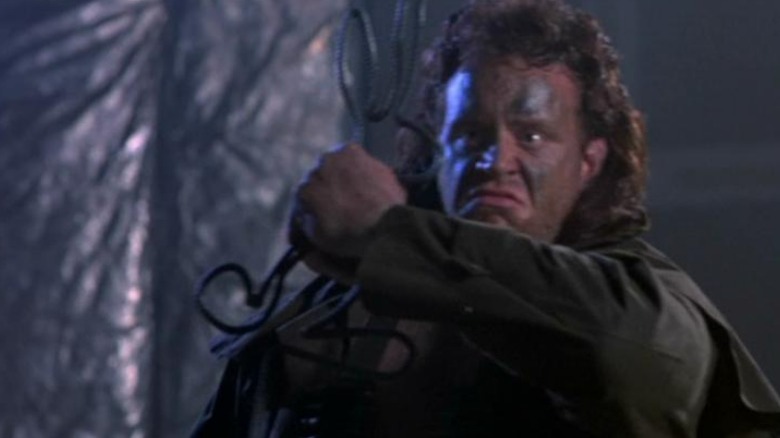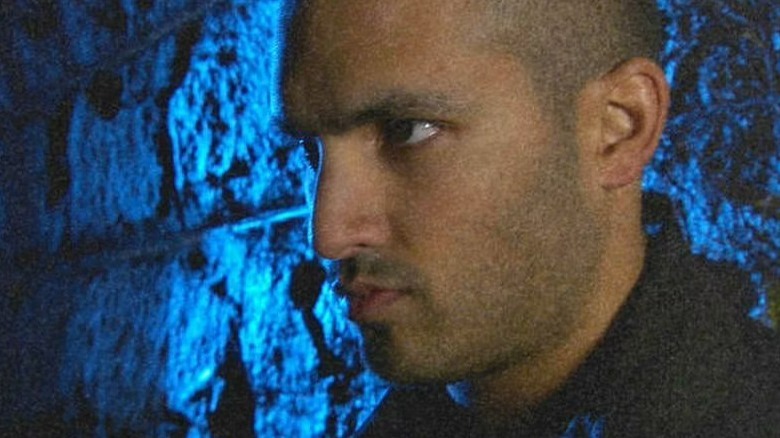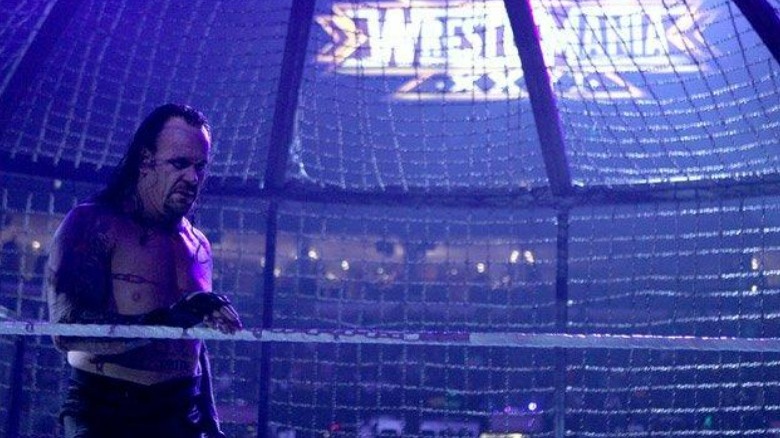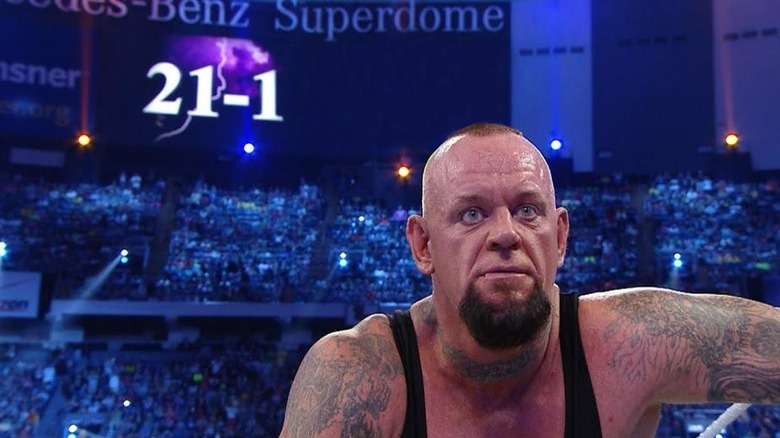Facts About The Undertaker Only Hardcore Fans Will Know
Survivor Series 1990 has gone down in professional wrestling history as one of the most significant events to ever hit the airwaves. Just before the bout between "The Million Dollar Man" Ted DiBiase's Million Dollar Team and Dusty Rhodes' Dream Team got underway, the former group had one last member to introduce. The sound of a sinister pipe organ flooded the arena as fans kept a close eye on the tunnel, where Brother Love followed a massive figure to the ring. The commentary team was in disbelief, and a hush fell over the crowd.
At long last, the Undertaker had arrived.
In the decades that followed, the Undertaker would become a staple of the WWE, earning a reputation as the measuring stick of what a wrestler should be. He'd win numerous championships, engage in classic matches and rivalries, evolve his on-screen persona, and most of all, leave an impression on the fans that will never disappear. Despite his retirement in 2020 after his WrestleMania 36 Boneyard Match against AJ Styles, and subsequent WWE Hall of Fame induction in 2022, his shadow still looms large over the company that he spent years atop.
Given how long the Undertaker spent as an active member of the WWE roster and how hard he worked to stay out of the public eye, some interesting facts about the Deadman — and the person behind him, Mark Calaway — tend to slip by the wayside. Here are some of those facts that you likely never knew or may have forgotten about over time.
The Undertaker wasn't his first wrestling identity
Long before he'd don his signature hat and trenchcoat and go by the Undertaker name, Mark Calaway began training as a professional wrestler in the late-1980s. Under the tutelage of the late Buzz Sawyer, he'd eventually get the chance to show off what he could do in World Class Championship Wrestling under the ring name Texas Red. There he'd wear a mask and take on Percival Pringle III — better known to WWE fans as Paul Bearer — as his manager, though by 1989, Calaway would join the United States Wrestling Association, ditch Pringle and the mask, and become the Master of Pain.
After a brief run in the USWA as the Master of Pain and in the World Class Wrestling Association as the Punisher, Calaway signed with World Championship Wrestling in 1989. This career move once again brought a name change, this time dubbing him "Mean Mark" Callous. During this era, he'd align with future Extreme Championship Wrestling mastermind Paul Heyman (known in 1990 as the Dangerous Alliance figurehead Paul E. Dangerously) and occasionally appear on New Japan Pro-Wrestling cards under the moniker "Punisher" Dice Morgan (via Cage Match). Thankfully, Calaway found more consistency as the '90s began.
He worried he'd hatch from an egg in his WWE debut
As Survivor Series 1990 rapidly approached, Mark Calaway wasn't sure what would become of him should WWF elect to add him to the roster. As he explained during his appearance on "The Broken Skull Sessions" in 2021, his first meeting with WWF chairman Vince McMahon didn't go as well as he'd hoped, especially after giving WCW his notice. His anxiety only worsened when a storyline involving a giant egg began on WWF television, which led him to believe that McMahon would want him to hatch from it for his big debut as a hypothetical character he referred to as "Egg Man."
"I had convinced myself to the point that my stomach hurt that I'm gonna be Egg Man," he recalled to Stone Cold Steve Austin during their interview, noting that the wacky gimmicks of the era didn't rule such an idea out. Luckily, Calaway never got stuck with such an outlandish character, and he noted during an appearance on the "Joe Rogan Experience" podcast that a subsequent phone call with Vince McMahon cleared the air. Thus, the Undertaker rose from the grave at Survivor Series, and the Gobbledy Gooker wound up emerging from the giant egg that same night.
His full name was originally Kane the Undertaker
Though Survivor Series 1990 served as the Undertaker's proper introduction to WWF audiences, he actually wrestled a few matches for the company before making it to the landmark event. According to Cage Match, his first bout happened on November 19, 1990, against Mario Manchini, and his second on November 20, against Rick Sampson. These matches took place on "WWF Superstars" and "WWF Wrestling Challenge," respectively, and didn't air until after Survivor Series, which made it all the more confusing when he was referred to as Kane the Undertaker on these broadcasts.
As it turns out, these two matches weren't total anomalies. In the weeks following their airings, the Undertaker would continue to take on the first name "Kane," even defeating Tugboat in an untelevised match under the moniker. However, by the time 1991 got underway, Kane the Undertaker became a thing of the past. From that point on, the powers that be shortened his name to simply the Undertaker, but the Kane name didn't end up going to waste. Glenn Jacobs later took it on when he re-debuted in WWE as Taker's storyline brother at Bad Blood: In Your House 1997.
He was part of a backstage group known as the Bone Street Krew
As the Undertaker's WWE career went on, fans would see the Demon of Death Valley accumulate loads of tattoos, with the "B.S.K. Pride" across his stomach standing out among the most eye-catching. B.S.K. stands for Bone Street Krew: a backstage group of friends that included the Undertaker, Charles "The Godfather" Wright, Yokozuna, Savio Vega, Rikishi, Paul Bearer, Brian Adams, Mr. Fuji, and the Godwinns. To provide some insight into this real-life faction, WWE.com interviewed a handful of its members and those who shared a locker room with them back in 2015. Suffice to say, their comments on its origin and history were fascinating.
During the chat, Wright noted that Yokozuna formally founded the group, and alongside the Undertaker, he took on the responsibility of inducting or rejecting new members. Yokozuna also came up with the name. As the group grew closer, Taker and some of the other members got B.S.K. tattoos, but don't let that trick you into thinking they were some kind of backstage powerbrokers. According to members of the B.S.K. and WWE legend Shawn Michaels, even though the Kliq (Michaels, Scott Hall, Kevin Nash, Triple H, and Sean Waltman) often rubbed most of the locker room the wrong way (via Sports Illustrated), the B.S.K. didn't band together to combat them. They just happened to form around the same time.
Undertaker served as the unofficial judge of Wrestlers Court
Speaking of the Undertaker's presence backstage, not only was he a notable member of the Bone Street Krew, but he also held a lot of authority in the locker room. He presided over Wrestlers Court, which served as a means of keeping the roster in check and punishing those who made life harder for their fellow wrestlers. As the unofficial judge of this interesting locker room ritual — a position that the likes of Triple H would take on occasion with JBL acting as prosecutor (via Sportskeeda) — the Undertaker would hear these cases that often got pretty serious in short order.
As he explained on "Hot Ones" in 2020, offenses like gimmick infringement, where someone would use another person's move or an element of their character without their permission, could make for tense situations. "Guys get hot, more so back in the earlier days than they do now, but I mean, it used to be if you did somebody else's move, there very well could be a scrap," he said, saying that Wrestler's Court existed to keep such situations and ones like them from getting out of hand. Of course, gimmick infringement was just one of many kinds of cases Taker would oversee.
Still, for as determined as he was to maintain some amount of order, the Undertaker isn't without his weaknesses. Just ask Edge and Christian, who once bought him off to avoid what could've been hefty repercussions (via "E&C's Pod of Awesomeness").
He was instrumental in Kane's WWE success
A big part of the Undertaker's legacy involves his brother of destruction, Kane. From their unforgettable match at WrestleMania 14 to their infamous clash with D-Generation X at Crown Jewel 2018, the two ring titans have created magic in the squared circle both as rivals and teammates. At the same time, it's worth remembering that by the time Kane debuted in 1997, Taker was already an established name. In that regard, his feud with The Deadman set the stage for his stellar career ahead, but what we saw on-screen wasn't the full extent of it.
As Glenn Jacobs described on his "Broken Skull Sessions" appearance (via 411Mania), even back when he wrestled under the Isaac Yankem D.D.S. character, Undertaker knew he was destined for bigger things. "He basically said, 'Dude, look, if you want to stay here, you're going to have to start being a lot more aggressive,'" Jacobs said, going on to explain that Taker was invested in seeing him succeed, so he pushed him to make improvements wherever he could to justify his presence on the roster. Sure enough, his hard work would pay off, and he'd land the Kane role, paving the way for him to collaborate with Taker further down the line.
Undertaker once choked Kurt Angle on a plane
In the list of the most naturally skilled athletes to ever step foot in a WWE ring, Kurt Angle easily resides at the very top. An accomplished amateur wrestler and an Olympic gold medalist, Angle's mat experience went a long way in preparing him for the world of professional wrestling. He won a world champion shortly after his arrival in the company, worked with legends like Stone Cold Steve Austin and The Rock, and became one of the defining stars of the Attitude and Ruthless Aggression eras. Still, none of his accolades or abilities could stop the Undertaker from legitimately choking him out.
The story goes that back in 2001, the WWE crew headed to the United Kingdom by plane for the Insurrextion pay-per-view event. On the ride over, Undertaker was out of it thanks to drowsiness and an ear injury, so naturally, he dozed off. Meanwhile, Angle and Vince McMahon decided to start wrestling for fun in the middle of the aisle, which eventually woke Taker up. "I come to, I look, I hear all this, and I see Kurt on Vince, right? And I just went 'Oh, hell no,'" he said on "The Broken Skull Sessions" (via TalkSport), so he got ahold of Angle and attempted to choke him out. Before things could really get ugly, Taker found out that it wasn't a real scrap, so he let Angle go and went back to sleep.
Jim Ross tried to give him the on-screen nickname Booger Red
Throughout his time in the WWE spotlight, the Undertaker has accumulated a laundry list of nicknames. The Deadman, the Last Outlaw, the Phenom, the Prince of Darkness, and many more have all become alternate monikers for the character. Be that as it may, not every nickname handed to him wound up sticking, especially the incredibly short-lived Booger Red. During Undertaker's run as the motorcycle-riding Big Evil in the early-2000s, commentator Jim Ross attempted to get fans behind this bizarre label. Suffice to say, it didn't catch on, hence why so few remember its brief existence.
Jim Ross went into detail in 2018 via his podcast, "Grilling JR," about his thinking behind the Booger Red name. "Booger Red was in reference to the great Texas linebacker, the late Tommy Nobis," Ross stated, explaining that Nobis bore a striking resemblance to the Undertaker in terms of his massive frame and red hair. He goes on to define a "booger" in this context as a frightening entity, so combining that with Taker's natural hair color created Booger Red. Ross admits that it wasn't exactly the best idea he ever had, and since he has had to explain it time and time again, it makes sense why it didn't endure.
He didn't want to go back to the Deadman gimmick at WrestleMania 20
Survivor Series 2003 pitted the Undertaker — who was in the midst of his motorcycle-riding, bandana-wearing Big Evil era at the time — against Vince McMahon in a Buried Alive match. Not long after the opening bell, Taker rendered his opponent a bloody mess, and his victory seemed inevitable. Unexpectedly, an easy win became a devastating loss when Kane interfered on McMahon's behalf and buried his brother alive. According to The Big Red Machine, his sibling hadn't embraced his dark side over the past few years, hence why he had no choice but to end him. Unsurprisingly, Taker wouldn't accept this defeat and began tormenting Kane from a distance on the road to WrestleMania 20.
When the Undertaker returned to face Kane at the landmark event in April of 2004, he also returned to his roots. He traded his Big Evil character for the stoic and supernatural Deadman once again — but behind the scenes, Mark Calaway wasn't so sure of this perceived backtrack. On Episode 143 of the "Something to Wrestle" podcast, Bruce Prichard said, "I gotta tell you, Mark Calaway hated the idea," before explaining that Calaway found his biker persona far more versatile in the ring. Nevertheless, he ultimately caved and let Big Evil go at WrestleMania 20, spending the remaining years of his career as the Deadman.
Undertaker has an odd relationship with cucumbers
Of the numerous backstage stories that have come to light about the Undertaker over the years, few have gained as much traction as his odd relationship with cucumbers. The late Paul Bearer famously lent a ton of credence to this rumor during an episode of "The Jim Cornette Experience", where he revealed that, thanks to some vague childhood experience, Taker couldn't stand to even look at the vegetable — even throwing up at a Waffle House because he noticed a cucumber slice in his iced tea. This led to countless locker room practical jokes where he'd wind up with cucumbers in his hat and gloves, and his reaction was never jovial.
Come 2020, the Undertaker himself finally broke his silence about his animosity toward cucumbers. On an episode of "Pardon My Take", he stated, "Okay, let's get this straight ... I'm not scared of cucumbers. I just don't like cucumbers, okay?" He then remarked that if someone presented him with one, he'd most likely get up and leave the room and that cucumber slices are especially good at getting on his bad side. Still, he didn't address Bearer's claim that his hatred for cucumbers stems from his childhood, so that's one aspect of this story the world will have to continue waiting for clarity on.
He has made a handful of appearances in films and television shows
The life of a WWE superstar is hectic, to say the least, especially for someone like the Undertaker. From the early 1990s to the early 2010s, Taker wrestled full-time for the company, meaning he was on the road for most of the year, performing in cities across the globe. That doesn't leave one much time for anything other than wrestling, but that hasn't stopped Mark Calaway from branching out and trying his hand at other forms of entertainment. When he's had the chance, he has made a few film and television appearances — some more well-remembered than others.
Calaway's formal acting debut came in 1991's "Suburban Commando," directed by Burt Kennedy. The film follows Shep Ramsey (played by fellow WWE mainstay Hulk Hogan) as he travels to Earth and attempts to adjust to suburban life. Calaway played an intergalactic bounty hunter named Hutch, who unsuccessfully worked with Knuckles (Tony Longo) to try and bring Shep in. Eight years later, he'd jump to television to make an appearance on "Poltergeist: The Legacy." He has also featured as the Undertaker on several talk shows and in the interactive Netflix film "Escape the Undertaker."
Undertaker almost had a storyline son
Since leaving WWE behind, Mark Calaway has opened up more about his personal life than he ever did while regularly appearing on TV as the Undertaker. That includes joining social media and becoming more public about his family life, making it common knowledge that he's a devoted husband and father. What many still don't know is that a storyline from the late-2000s nearly saw the Undertaker character become a father himself. The WWE creative team unceremoniously ended the angle before it could get off the ground, even though the seeds for it still wound up planted.
If you kept a close eye on WWE programming around 2008, you might remember a series of vignettes promoting the arrival of Hade Vansen. He never properly debuted, but if he did, it would've begun a storyline focused on his relation to the Undertaker. Freddie Prinze Jr. told the story on the "Wrestling with Freddie" podcast, recalling that Vince McMahon wanted someone fresh for Taker to feud with, so they chose Vansen. Then discussions of him claiming to be his son began, but before that revelation would make it to "Raw" or "Smackdown," Triple H said that Vansen didn't look credible enough. Thus, the story never materialized, and Vansen was released shortly after.
His own pyro accidentally set him on fire during his entrance
Compared to some of the other entrances in WWE history, the Undertaker's is typically rather simple in execution. The lights go dim, fog fills the arena, his foreboding music blares, and he makes his way toward the ring with a methodical stride. To spice things up, sometimes pyro displays or druids holding torches join the fray. Despite its relative simplicity, though, it's one of the most iconic entrances in wrestling history, and it never failed to get fans on their feet. Even still, it hasn't always gone off without a hitch. Take the Elimination Chamber 2010 pay-per-view, for example, where Taker went up in flames during his routine walk to the ring.
Ready to defend his World Heavyweight Championship inside the Elimination Chamber against Chris Jericho, John Morrison, R-Truth, CM Punk, and Rey Mysterio, the Undertaker walked down the ramp like he would on any other night. On this occasion, however, his entrance pyrotechnics went off too close, setting him on fire and forcing him to scramble to the squared circle a bit faster than normal. Once inside his Elimination Chamber pod, crew members doused him with water, but it did little to ease the pain of his burns. Ever the professional, he worked the match anyway, but he wasn't happy with the pyro operator (via "The Broken Skull Sessions").
Many names were considered to end Undertaker's WrestleMania undefeated streak
For over two decades, the Undertaker ruled WWE's biggest event of the year, WrestleMania. The likes of Triple H, Shawn Michaels, Jake "The Snake" Roberts, and more attempted to defeat him on the Grandest Stage of Them All, only to fail and join a long list of competitors who couldn't stop the Deadman. With 21 victories under his belt, Taker entered WrestleMania 30 with the intention of making Brock Lesnar his next victim. That infamously never came to pass, and the Beast Incarnate snapped the streak in New Orleans that night — something several others nearly did in years previous.
On the Something to Wrestle podcast, Bruce Prichard recalled backstage discussions around the time of WrestleMania 22 that Mark Henry should end the Undertaker's undefeated streak. He said that the idea came from Vince McMahon himself, and Taker even agreed with the plan. For a few weeks, Henry's WrestleMania win was in the cards, but as we know, he didn't come away from the event as the victor. At the last moment, McMahon got cold feet and decided to keep the streak alive instead.
Fast forward to the road to WrestleMania 24, and once again the Undertaker's streak nearly came to an end. This time the WWE creative team offered the honor to Edge, who, at the time, sat atop "Smackdown" as the World Heavyweight Champion. Without even considering it, he immediately shot the idea down, citing his belief that if the streak had to end, it should only when Taker was ready to retire. Besides, as he told SportsNation on ESPN+, Edge didn't feel he needed that impressive of an accolade on his record at that point in his career
Kurt Angle also revealed that the Undertaker's streak almost ended by his hand. He claimed that in 2006, Taker approached him and expressed his desire to make a defining WrestleMania match with him. To do so, he was even on board to lose to the Olympic gold medalist, but Vince McMahon didn't care much for the idea. Angle says he agreed with McMahon, and so he didn't end the streak, much less face the Undertaker at WrestleMania that year or any other.
